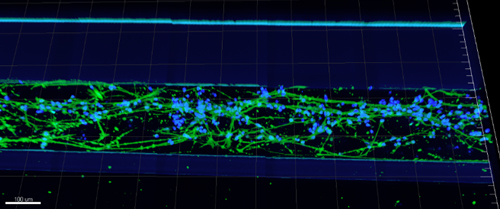Scientists around Prof. Dr Jens Schwamborn from the Luxembourg Centre for Systems Biomedicine (LCSB) of the University of Luxembourg have developed a novel in vitro model to test drug candidates against Parkinson’s disease (PD).
PD is a complex neurodegenerative disorder and it is very difficult to recreate the onset and progression of the disease in conventional in vitro models such as standard cell cultures. The identification of promising drug candidates and the development of personalised medicine is hindered by this lack of accurate in vitro models. In order to offer an alternative to the existing tools, researchers of the LCSB have been working on cell cultures in 3D. Their results, recently published in Advanced Science, show that cells cultivated in a 3D system recapitulate key features of PD. “This is the first time we observed such a degeneration in a cell culture of PD patient-specific neurons”, explains Prof. Schwamborn, lead author of the article and head of the Developmental and Cellular Biology group at the LCSB. “It is a step toward a better representation of the disease and it supports the use of advanced 3D in vitro models for future patient stratification and personalised drug development.”
Growing cells in 3D environments
When studying Parkinson’s disease, researchers mainly focus on the dopaminergic neurons located in the midbrain. Pluripotent stem cells can be used to generate this type of neurons but standard 2D cell cultures do not offer an ideal set-up to study these highly-ramified nerve cells. On the other end, previous studies have shown that cells grown in 3D environments exhibit phenotypes that resemble in vivo conditions, notably in the context of Alzheimer’s disease, and that the cellular responses to drug administration in 3D were closer to in vivo results. With that in mind, researchers from several groups at the LCSB collaborated in order to optimise the cultivation of neurons derived from PD patient stem cells in a 3D cell culture environment. In this environment, a 3D Matrigel matrix provides support, permits vertical growth and accelerate neuronal network formation. This set-up also permits automated image analysis and improves reproducibility.

Neuronal cultures differentiated for 6 weeks (green Tuj1, blue Hoechst)
Neurons expressing key hallmarks of the disease
The dopaminergic neurons cultivated in the 3D cell culture system expressed very clear disease phenotypes: decreased differentiation and ramification, altered mitochondrial morphology and increased cell death. Most of all, those neurons also showed signs of time-dependent dopaminergic degeneration, which was never observed in a 2D cell culture. The neurons cultivated carried a specific mutation (LRRK2-G2019S) and some of the disease phenotypes – but not all – could be reversed with the administration of a drug targeting that mutation, indicating that other genetic factors contribute as well. Indeed, a global analysis showed that the whole genetic background of the PD patients constituted the strongest contribution to the phenotypes. Those results highlight how this new in vitro model recapitulates key cellular hallmarks of the disease and allows a systems-level understanding of the effects of a given mutation.

Dopaminergic neurons differentiated for 6 weeks (red TH, blue Hoechst)
A promising tool for patient stratification and drug tests
Since the genetic background of each patient might mediate and enhance the effect of a mutation, proper patient stratification is essential for the identification of the best therapeutic choices. The use of advanced personalised in vitro models, such as this 3D set-up, could help with both patient stratification and tailored drug development. “Further studies are now necessary to bring the present work to clinical application and to fuel our understanding of the disease pathogenesis”, concludes Prof. Schwamborn.
—
Reference: Silvia Bolognin, Marie Fossepre, Xiaobing Qing, Javier Jarazo, Janez Ščančar, Edinson Lucumi Moreno, Sarah L. Nickels, Kobi Wasner, Nassima Ouzren, Jonas Walter, Anne Grünewald, Enrico Glaab, Luis Salamanca, Ronan M. T. Fleming, Paul Antony and Jens C. Schwamborn, 3D culture of Parkinson’s disease-specific dopaminergic neurons for high content phenotyping and drug testing, Advanced Science, 20 November 2018. https://doi.org/10.1002/advs.201800927
Funding: This research is supported by the Luxembourg National Research Fund (FNR). This is part of an EU Joint Programme – Neurodegenerative Disease Research (JPND) project. Further support comes from the SysMedPD project (Horizon 2020).
